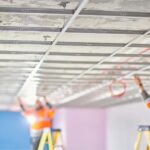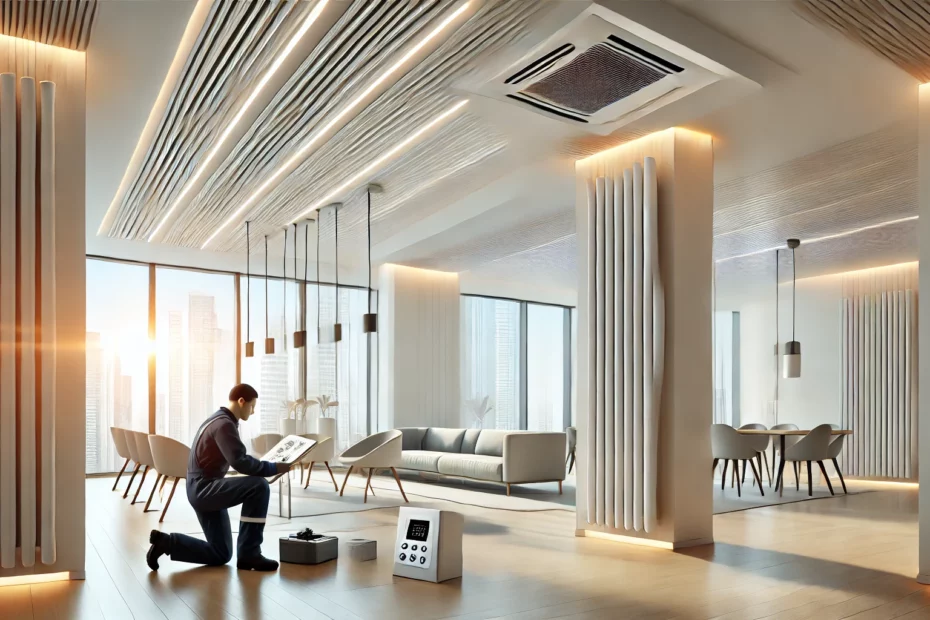Ceiling radiant heating systems offer optimum thermal comfort, while being discreet and energy-efficient. However, like all equipment, regular maintenance is necessary to ensure their performance and longevity. Although these systems are designed to be durable and low-maintenance, it is essential to follow certain best practices to ensure optimal long-term performance.
In this article, we’ll review the main points to check when maintaining radiant heating systems, as well as tips for maintaining their efficiency.
Recommended maintenance frequency
One of the advantages of radiant ceiling heating systems, such as the Modular Radiant Ceiling (PRM) or Gypsum Radiant Ceiling (PRP), is that they don’t require as frequent maintenance as traditional forced-air heating systems. In fact, the absence of moving parts, filters to replace or ducts to clean considerably reduces maintenance requirements.
However, an annual inspection is recommended to ensure that the system is working properly. This will ensure that there is no visible damage to the heating panels, and that the electrical system powering them is in good condition.
Key points to check during inspection
When servicing a radiant heating system, a number of factors must be taken into account to ensure optimal operation:
- Heater panel condition
Radiant panels should be inspected to ensure that they are intact and that no cracks or damage are visible on the surface. Damaged panels may affect heat distribution. - Checking the electrical system
As the radiant heating system is powered by electricity, it is crucial to check the electrical connections to prevent any risk of short-circuit or poor contact. A qualified electrician must be called in for this inspection. - Thermostats and control systems
The thermostats that regulate the temperature of the radiant heater should also be checked. Incorrect thermostat calibration can lead to excessive energy consumption or inefficient temperature control. Make sure the settings are correctly configured to optimize energy efficiency.
Maintain the thermal efficiency of your system
To ensure that your radiant heating system continues to operate at maximum efficiency, here are a few maintenance tips to apply regularly:
- Clean panel surfaces: Although radiant heating does not generate airflow, dust and debris can accumulate on the panels over time. Gentle cleaning of the panel surface with a dry or slightly damp cloth helps maintain even heat distribution.
- Monitor room temperature: Thermostats should be set to maintain a stable temperature, without overheating the space. This not only improves thermal comfort, but also extends system life and reduces energy costs.
- Insulate spaces properly: Effective insulation of ceilings and walls helps minimize heat loss, thus optimizing the performance of the radiant heating system. If insulation is inadequate, the system will have to work harder to maintain a constant temperature, which could reduce efficiency and increase energy costs.
A sustainable and practical heating system
Radiant ceiling heating systems, such as PRM and PRP, are designed to last for many years with minimal maintenance. By following these simple maintenance tips, you can extend their lifespan while maintaining energy efficiency and thermal comfort.
Although maintenance is limited, it’s important not to neglect annual checks, and to call in qualified professionals for technical inspections. This will prevent any problems and ensure optimal long-term performance.
- What is a hydraulic heating ceiling? Definition and operating principles
- Hydraulic ceiling heating vs. underfloor heating: Which solution is more efficient?

- The advantages and disadvantages of hydraulic ceiling heating: Complete guide

- The Myth of Rising Heat: Demystifying and Explaining the Heated Ceiling

- Radiant Heating Ceilings : The Revolutionary Efficiency of an Unprecedented System


